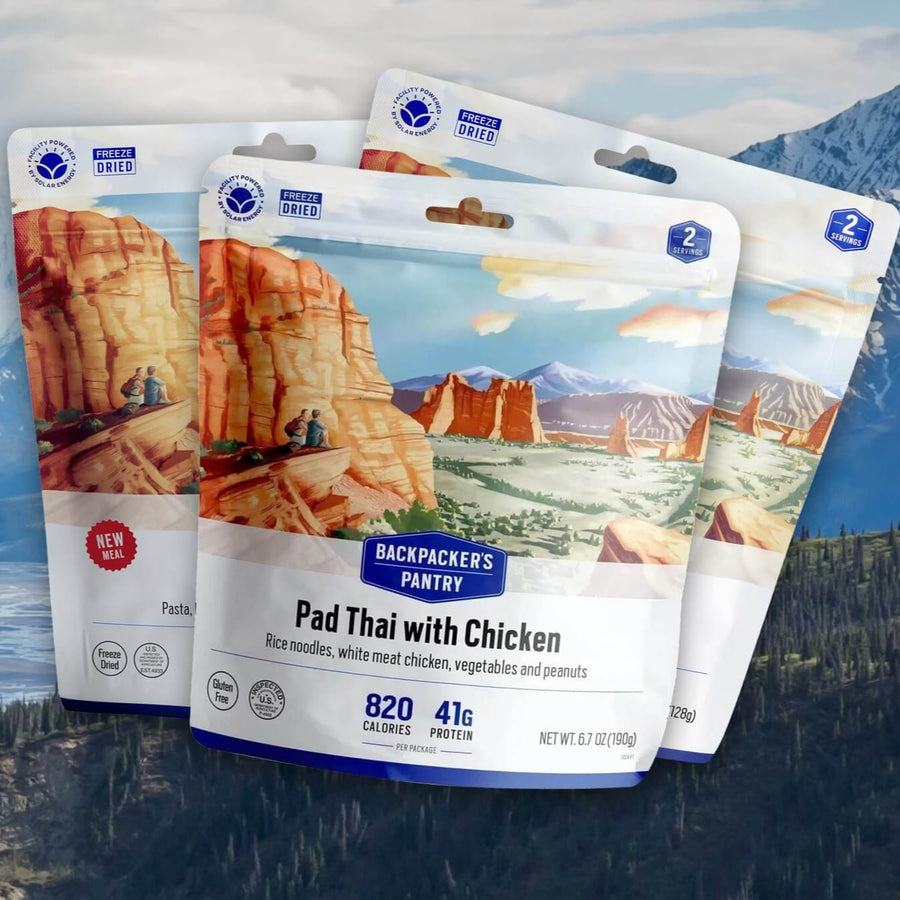Freeze Dried Food 101: What is it? How it’s Made? And More
It sounds like science fiction or made for astronauts, but freeze-dried food is no mystery. If you’ve ever wondered how we pack tasty and nutritious meals into a lightweight pouch that can be ready to eat in minutes, you’re in the right place. Today, we’re going to cover everything you need to know about freeze-dried food, including why these meals are the perfect addition to your camping and hiking trips.
What is Freeze-Drying?
Freeze-drying, also known as lyophilization, is a dehydration process used to preserve perishable materials, improve the shelf life of foods, and make them more convenient (and lighter) for transport.
The process works by quickly freezing the material, then reducing the surrounding pressure and adding heat to allow the frozen water in the material to sublimate directly from the solid phase to the gas phase. This means water is removed without going through a liquid phase, which can be beneficial in preserving the physical structure of the material.
How is Freeze-Dried Food Made?
To make freeze-dried meals, we first cook and prepare the meals. Freeze-drying does not cook the meals, it simply removes the water content. It follows these basic freeze-dried processes.
- Preparation & Cooking: The food, whether it's a fruit, vegetables, meat, or a complete meal, is selected and prepared. This involves peeling, slicing, cooking, and seasoning.
- Freezing: The food is placed in a special freezer where it's frozen solid. This freezing process is typically much colder than your home freezer. The objective is to freeze the food as quickly as possible to form small ice crystals, which helps to maintain the food's cellular structure.
- Primary Drying (Sublimation): After the food is frozen, it's placed into a vacuum chamber. A vacuum is pulled to lower the pressure around the food, and slight heat is applied. This allows the ice within the food to sublimate, or transition directly from a solid (ice) to a gas (water vapor), bypassing the liquid state.
- Secondary Drying (Desorption): After the ice has been removed, the food undergoes a second drying phase to remove any remaining water molecules. The temperature is raised higher than in the sublimation phase, and this process can take several hours to complete.
- Packaging: The freeze-dried food is then sealed in moisture and oxygen-proof packaging, often with an oxygen absorber to ensure it remains fresh. This packaging prevents bacterial growth and oxidation, allowing the food to be stored for years without refrigeration.
Is Freeze-Drying Food the Same as Dehydrating it?
It’s a common misconception, but the two processes are very different. Freeze-drying and dehydrating are both methods to remove water from food to preserve it, but they are not the same process and the results can be quite different. When dehydrating food via a machine, the machine circulates hot, dry air across the food, removing most of the water. These two types of food have different tastes, textures, and weights.
Freeze Drying vs. Dehydrating Food
Dehydration: This process involves circulating hot, dry air across the food to evaporate the water content. It can be done with an oven or a dehydrator. Dehydration typically results in a loss of up to 90-95% of the water content. The process can cause the food to shrink and often changes the texture, making it more chewy or crispy. It also can lead to some loss of flavor and nutritional value, particularly heat-sensitive nutrients like Vitamin C.
Freeze-drying: Freeze-drying can remove up to 99% of the water content. Because it takes place at low temperatures, freeze-drying better preserves the food's original texture, flavor, and nutritional content compared to dehydration. The freeze-dried food also tends to rehydrate more quickly and effectively compared to dehydrated food.
How Long Does Freeze-Fried Food Last?
Freeze-dried foods are popular in the emergency preparedness world, and for good reason. Since the moisture content has been almost completely removed, these foods can last for up to 25 years when processed and packaged in certain ways.
Most of our meal pouches can last for up to 7 years. That means you can purchase meals for camping and hiking, or emergency preparedness without worrying about eating them that weekend, or even that year.
When Did People Start to Freeze-Dry Food?
Freeze drying seems like a modern way of processing food, however, it dates back to the 15th century! The Aymara -- people in Bolivia's high Andes -- figured out how to freeze-dry potatoes without pumps or pipes or a freezer. By using the freezing mountain temperatures and the strong sun, they have been able to freeze-dry potatoes for centuries. Learn more about their ancient freeze-drying method here.
The modern process of freeze-drying that we're familiar with today was developed during World War II as a way to preserve blood plasma and penicillin. It was discovered that these materials, which were needed for treating wounded soldiers, could be freeze-dried and therefore transported and stored much more easily.
After the war, the process was adapted for use with food. One of the first uses was for coffee, resulting in the instant coffee that is still widely used today. In the 1960s, freeze-dried food was used by NASA for astronaut meals because of its lightweight and long shelf life.
Why Freeze-Dried Food is Perfect for Camping And Hiking
Freeze-dried food is lightweight and tastes great, but the benefits go well beyond those basics:
- Nutrition: The freeze-drying process does a good job at preserving the nutritional content of food. That means you’ll be fueling up with the nutrients your body needs to keep hiking, backpacking, and more.
- Ease of preparation: There’s no easier way to prepare your breakfast, lunch, dinner, and snacks on the trail than with freeze-dried food. Just take a look at the directions on some of our most well-loved meals. It doesn’t get easier than adding hot water, stirring, and waiting for your food to rehydrate.
- International flavors: Freeze-dried food has come a long way in recent years, with meals that range from Pad Thai to Lasagna, and so much more. You can find something you love for every meal, including dessert. Food intolerances and allergies aren’t a problem, either, since you can buy meals that are gluten-free, soy-free, dairy-free, and more.
So, what are you waiting for? Stock up on some freeze-dried foods for your next nature outing, and experience how these meals help you spend less time preparing food, and more time enjoying the outdoors.
Is Freeze Dried Food Healthy?
Freeze-dried food can be a healthy option, especially when compared to other preservation methods. Freeze-dried foods retain around 97% of their nutrients, compared to 50% - 60% nutrient retention with dehydrated foods. Unlike canning or heat-based dehydration methods, freeze-drying is done at low temperatures, which helps to retain much of the food's original nutritional value.
Freeze-dried fruits and vegetables, for instance, retain most of their vitamins and antioxidants, making them a healthy choice. Similarly, freeze-dried meats and meals can retain their protein content and other nutrients.
Can You Freeze Dry Food At Home?
Freeze-drying requires precise control over temperature and pressure to effectively sublimate the water content without causing damage to the food, making it difficult to achieve at home. To properly freeze dry food, specialty equipment is needed, which can come at a significant cost.





